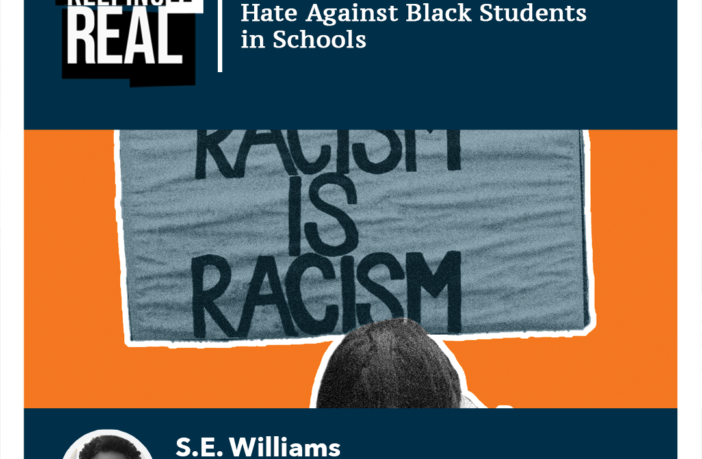Last Updated on February 6, 2024 by BVN
S.E. Williams
When claims of “Racism as a Public Health Crisis” rang out in 2020 calling for an overdue plan of action to heal its victims as COVID-19 and the murder of George Floyd collided with a new generation of activists, their sense of urgency for change was palpable. Conditions in America compelled them to picked up the torch of justice as they breathed new life into the struggle for equity and equality,
Despite these efforts and the municipal declarations made in response, some of the most important areas of concern, including acts of racism against Black children and youth, remain unchanged. In fact, acts of hate perpetrated against them have increased exponentially according to the just released Hate Crime at Schools report that explored incidents of hate at schools across the country for the years 2018-2022.
During the five year study period over 30% of juvenile victims of hate crimes in the country experienced the offense while at school. And in 2022, according to the report, data shows 66% of the race-based hate incidents that occurred in U.S. schools that year targeted Black students. To learn more about the findings see our recently published article, Black Students #1 Target of Anti Bias Attacks at School.
Sadly, the findings were not an aberration. Cumulatively, the numbers not only reflect findings revealed in the FBI’s overall hate crimes report, they also are reflective of the incidents of anti-bias hate against Black students each individual year of the five year study period.
While considering these results it struck me that while we may lament and opine about the reality in the data, maybe as a Black community, we need to do less contemplating and more noise making. When Asian hate crimes increased during the pandemic, the nation lost its mind and threw everything but the kitchen sink at getting attention on the issue. When immigrant children were placed in cages during the Trump administration, it drew international condemnation. When hate crimes against the Muslim community spiked in the wake of 911, the national media paid attention and supportive communities rallied in response. And, whenever tensions rise in the Middle East or extremists spout words of hatred against the Jewish community, many Americans are apoplectic in demanding an end to anti-semitism.
But, when year after year, incidents of anti-bias hate against Blacks outpace every other group by leaps and bounds; when year after year acts of hate against Black children, youth and emerging adults at schools outpace other groups in great numbers, we must ask ourselves, where is the similar outrage? Where are the calls to action? Where are the national and statewide anti-hate campaigns? Where is the federal/statewide funding to focus like a laser on this issue?
Yes, there is funding for anti-hate campaigns and such campaigns are certainly warranted. But where is the specific, targeted effort to put an end to the hatred aimed at our children, our youth, our young adults, Black people in general, being experienced and tallied year after unrelenting year?
In 2023, a study published by the American Journal of Psychiatry showed that racial inequities (including trauma) can lead to changes in the brain structure of children causing conditions like post-traumatic stress disorder. (source: stock.adobe.com)
I don’t mean to imply that major incidents of hate against Black people are ignored. Certainly, there is always an outpouring of response when occurrences like the massacre at Mother Emanuel Church or the slaughter at the Buffalo grocery store or the COVID-19 pandemic, or the murder of George Floyd or, or, or. But, when it comes to the death of Black dignity, Black mental health, by a thousand cuts year after year, there is silence.
We in the Black community should be demanding more attention, more mitigation, more funding focused specifically on this issue. Consider this—bias motivated hate crimes against Blacks in schools went from 237 in 2018 (the highest among any group) to 547 in 2022 (again the highest in any group). This reflects a 230% increase in anti-bias crimes against Blacks in the nation’s schools. Again, where is the outrage?
I don’t mean outrage without reason. I mean outrage against the threats to the future of Black children.
These acts of hate go far beyond just hurt feelings. A policy statement from the American Academy of Pediatrics (AAP) issued in 2020, declared, “Racism is a social determinant of health that has a profound impact on the health status of children, adolescents, emerging adults, and their families.”
The statement further noted that evidence to support the continued negative impact of racism on health and well-being through implicit and explicit biases, institutional structures, and interpersonal relationships is clear.
“We can not tolerate or turn a blind eye to racism and exclusion in any form and yet claim to defend the sacredness of every human life.”
Pope Francis
In 2023, a study published by the American Journal of Psychiatry showed that racial inequities (including trauma) can lead to changes in the brain structure of children causing conditions like post-traumatic stress disorder.
The AAP policy statement stressed the importance of acknowledging the role of racism in child and adolescent health. It noted how such acknowledgement will empower pediatricians and other health professionals “to proactively engage in strategies to optimize clinical care, workforce development, professional education, systems engagement, and research in a manner designed to reduce the health effects of structural, personally mediated, and internalized racism and improve the health and well-being of all children, adolescents, emerging adults, and their families.”
This is great, but we should be preventing such psychological/emotional damage even more aggressively than we are working to mitigate it.
Although the Hate Crimes at Schools report was not disaggregated by state, the need for targeted awareness, prevention and mitigation exists. Experts note how such acknowledgement is important and yet, when strategies for anti hate programs are funded and discussed, the historical fact that Blacks continue to be the most attacked group in the area of anti-bias overall, and Black children, youth and emerging adults specifically, year after year, it is rarely, if ever mentioned as a stand alone concern, let alone highlighted as an area of critical importance. It is usually swallowed up as part of the general concern.
Take for example consider this press release from last May titled Governor Newsom Announces the Launch of CA vs Hate, a New Statewide Hotline to Report Hate Acts in California, although Black Americans were ticked off on the list of communities targeted, there was nothing in the memo that pointed out their status as being consistently the most targeted group year after year; or this press release issued in June, 2023, from the CA Civil Rights Department titled, In First Month Since Official Launch, California vs Hate Receives 180 Reports of Hate Acts Across California and Connects Californians with Support, not a mention of the need to focus on anti-Black bias.
In September 2023, Cal Matters reported that although Blacks in the state of CA only represent 6% of the population, they represent about 30% of its reported hate crime victims and yet “the Black community appeared to receive only a fraction of the grants the state is disbursing.” These comments were made in reference to the $90 million in grant funding California is spending to fight hate.
Based on the data, there is little doubt the Black community has a right to demand more.
Of course, this is just my opinion. I’m keeping it real.



